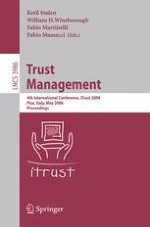This volume constitutes the proceedings of the 4th International Conference on Trust Management, held in Pisa, Italy during 16–19 May 2006. The conference followed successful International Conferences in Crete in 2003, Oxford in 2004 and Paris in 2005. The ?rst three conferences were organized by iTrust, which was a working group funded as a thematic network by the Future and Emerging Technologies(FET) unit of the Information Society Technologies(IST) program of the European Union. The purpose of the iTrust working group was to provide a forum for cro- disciplinary investigation of the applications of trust as a means of increasing security, building con?dence and facilitating collaboration in dynamic open s- tems. The aim of the iTrust conference series is to provide a common forum, bringing together researchers from di?erent academic branches, such as the technology-oriented disciplines, law, social sciences and philosophy, in order to develop a deeper and more fundamental understanding of the issues and ch- lenges in the area of trust management in dynamic open systems. The response to this conference was excellent; from the 88 papers submitted to the conference, we selected 30 full papers for presentation. The program also included one keynote address, given by Cristiano Castelfranchi; an industrial panel; 7 technology demonstrations; and a full day of tutorials.
